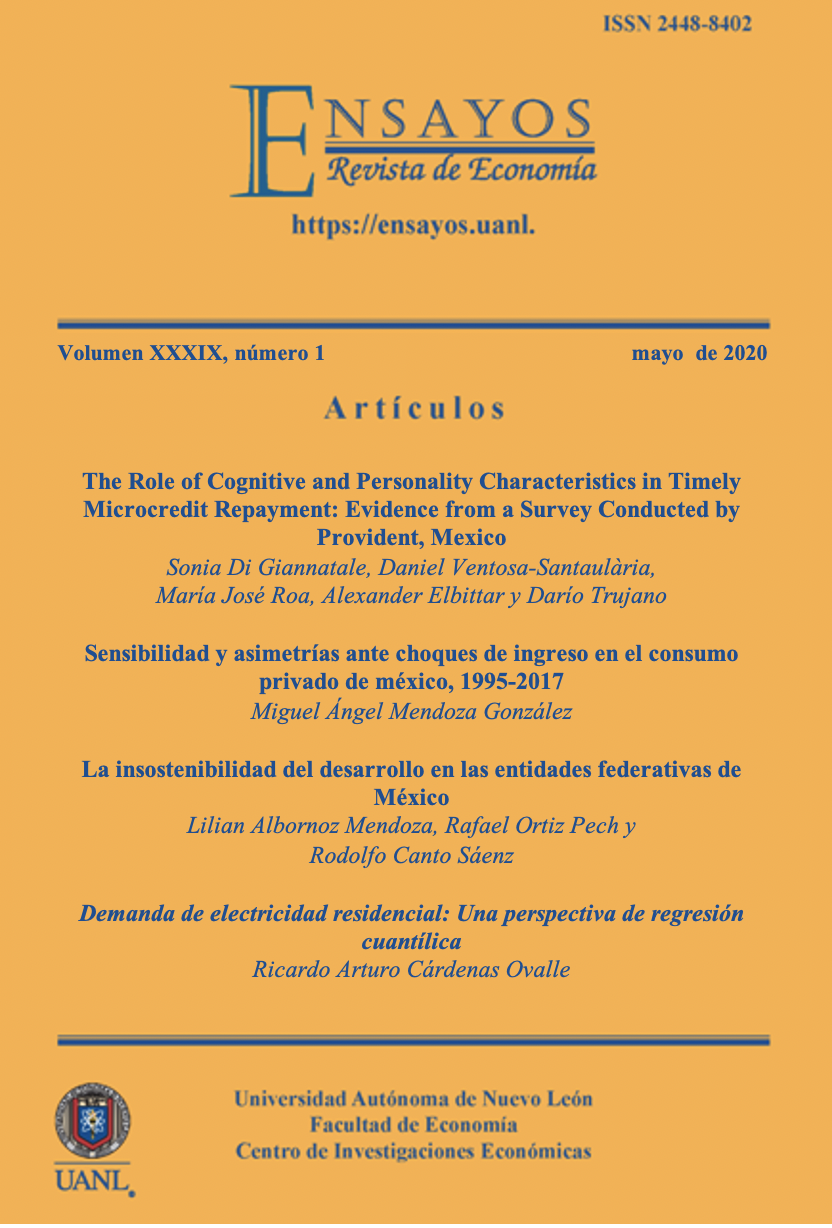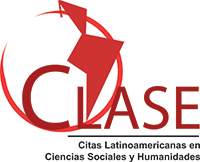Sensibilidad y asimetrías ante choques de ingreso en el consumo privado de México, 1995-2017
DOI:
https://doi.org/10.29105/ensayos39.1-2Palabras clave:
Sobre-sensibilidad del consumo, Asimetrías ante choques de ingreso, Cointegración con regímenes múltiples, Modelos VECM con regímenes múltiples, TVECMResumen
Esta investigación analiza con un enfoque poskeynesiano la sobre-sensibilidad y las asimetrías ante choques de ingreso del consumo privado y su desagregación en bienes duraderos, semi-duraderos, no-duraderos y los servicios en México para el período 1995-2017. Para estimar la sobre-sensibilidad se utilizan las metodologías de cointegración de Johansen-Juselius y el método de estimación FMOLS, sin sesgo de endogeneidad de Phillips y Hansen. Para las asimetrías se aplican las pruebas de Seo y Hansen-Seo de cointegración, con regímenes múltiples (cointegración-threshold) y modelos TVECM de vectores de corrección de error, con regímenes múltiples de Seo. Con los resultados se comprueba la existencia de sobre-sensibilidad del consumo privado y del consumo de la mayoría de los bienes por durabilidad (nacional e importado) y comportamientos asimétricos de régimen bajo, consistente con un escenario de crisis económica.
Sensitivity and asymmetries of income shocks in Mexico's private consumption, 1995-2017
ABSTRACT
With a Postkeynesian approach, this research analyzes the over-sensitivity and asymmetries of income shocks of private consumption and its unbundling into durable, semi-durable, non-durable goods and services in Mexico for the period 1995-2017. To estimate over-sensitivity to income, cointegration methodologies from Johansen-Juselius are used and the FMOLS estimation method without endogeneity bias of Phillips and Hansen. And, for the asymmetries, this study applies the tests of Seo and Hansen-Seo of cointegration with multiple regimes (threshold-cointegration) and threshold vector error correction model (threshold-VECM) with multiple regimes of Seo. The results show the existence of over-sensitivity of private consumption and durability for most of the goods (national and imported) and low-level asymmetric behaviors consistent with a scenario of economic crisis.
Descargas
Citas
Arrau, P. and Oks, D., 1992. El ahorro privado en México, 1980-1990. Economía Mexicana. Nueva Época, 1(2), pp. 311-378.
anonimo, 2018. Las remesas en el contexto de los determinantes del consumo privado en México, 1995-2017, México: Documento de trabajo.
Bayoumi, T. and Sgherri, S., 2007. On tne impact of income and policy shocks on consumption, Amsterdam, The Netherlands: De Nederlandsche Bank, working paper, No. 152.
Blundell, A., Browne, F., Cavaglia, S. and Tarditi, A., 1992. Finacial Liberalisation and Consumption Behaviour, s.l.: Economic Research Department, Reserve Bank of Australia.
Bunn, P., Leroux, J., Reinold, K. and Surico, P., 2017. The consumption response to positive and negative income changes, London: Bank of England, Working Paper No. 645.
Campbell, J. Y. and Mankiw, N. G., 1989. Consumption, Income, and Interest Rates: Reinterpreting the Time Series Evidence. NBER Macroeconomics Annual, Issue 4, pp. 185-216.
Campos, V. R. y Meléndez, Á. M., 2013. Una estimación semiparamétrica de las pautas de consumo e ingreso a lo largo del ciclo de vida para México. El Trimestre Económico, octubre-diciembre(320), pp. 805-840.
Carbajal De Nova, C. y Goicoechea, J., 2014. Consumo privado por origen y componente: efectos ingreso y precio para México. investigación económica, LXXIII(289), pp. 111-139.
Castillo Ponce, R. A., 2003. Restricciones de liquidez, canal de crédito y consumo en México. Economía mexicana, XII(1), pp. 65-101.
Castro, C., Loría, E. y Mendoza, M. A., 1997. Eudoxio; Modelo Macro econométrico de la Economía Mexicana. México: Facultad de Economía, UNAM.
Commault, J., 2017. How Does Consumption Respond to a Transitory Income Shock? Reconciling Natural Experiments and Structural Estimations, France: Ecole Polytechnique and CREST.
de la Cruz, J. L. y Alcántara, J. Á., 2011. Crecimiento económico y el crédito bancario: un análisis de causalidad para México. Revista de Economía, XXVIII(77), pp. 13-38.
Dickey, D. A. and Fuller, W. A., 1979. Distributions of the Estimators For Autoregressive Time Series with a Unit Root. Journal of the American Statistical Association, Issue 75, pp. 427-431.
Dickey, D. A. and Fuller, W. A., 1981. Likelihood Ratio Statistics for Autoregressive Time Series with a Unit Root. Econometrica, Issue 49, pp. 1057-1072.
Elliott, G., Rothenberg, T. and Stock, J., 1996. Efficient Tests for an Autoregressive Unit Root. Econometrica, 64(4), p. 813–836.
Engle, R. and Granger, C., 1987. Co-integration and Error Correction: Representation, Estimation, and Testing. Econometrica, Issue 55, pp. 251-276.
Friedman, M., 1957. A Theory of Consumption Function. s.l.:Princeton: Princeton University Press.
Galindo, L., 1993. Los determinantes de corto y largo plazos del consumo en México (1960-1988). Un análisis con mecanismo de corrección de errores y cointegración. Investigación Económica, 206(4), pp. 177-207.
González García, J. R., 2002. La Dinámica del Consumo Privado en México. Un Análisis de Cointegración con Cambios de Régimen, México: Documentos de Investigación, Banxico.
Hall, R., 1978. Stochastic implications of the life-cycle permanent income hypothesis: theory and evidence. Journal Political Economy, Issue 86, pp. 971-987.
Hansen, B. E. and Seo, B., 2002. Testing for two-regime threshold cointegration in vector error-correction models. Journal of Econometrics, Issue 110, pp. 293-318.
Jappelli, T. and Pistaferri, L., 2010. The Consumption Response to Income Changes. Annual Review of Economics, Issue 2, pp. 479-506.
Johansen, S. and Juselius, K., 1990. Maximum Likelihood Estimation and Inference on Cointegration – with Applications to the Demand for Money. Oxford Bulletin of Economics and Statistics, 52(2), pp. 169-210.
Johansen, S., 1992. A Representation of Vector Autoregressive Processes Integrated of Order 2. Econometric Theory, 8(02), pp. 188-202.
Kirchgässner, G. and Wolters, J., 2007. Introduction to Modern Time Series Analysis. 1er edición ed. Berlin Heidelberg: Springer.
Krueger, D. and Perri, F., 2011. How do Households Respond to Income Shocks?, Pennsylvania: CEPR and NBER.
Kwiatkowski, D., Phillips, P., Schmidt, P. and Shin, Y., 1992. Testing the Null Hypothesis of Stationarity Against the Alternative of a Unit Root: How Sure Are We That Economic Time Series Have a Unit Root?. Journal of Econometrics, Volumen 54, p. 159–178.
Lavoie, M., 1994. A Postkeynesian Approach to Consumer Choice. Journal of Post Keynesian Economics, 16(4), pp. 539-562.
Lavoie, M., 1994b. Post Keynesian consumer theory: Potential synergies with consumer research and economic psychology. Journal of Economic Psychology, Issue 25, pp. 639-649.
Ludwig, J., 2015. Is there heterogeneity in the response of consumption to income shocks?, Dortmund, Germany: Ruhr-Universität Bochum (RUB), Department of Economics, Economic Papers, No. 595.
Mallick, S. K. and Mohsin, M., 2016. Macroeconomic Effects of Inflationary Shocks with Durable and Non-Durable Consumption. Open Economic Review, Issue 27, pp. 895-921.
Miller, J. L. C., 2013. Crédito bancario y crecimiento económico en México. Economía Informa, Issue 378, pp. 14-36.
Pérez López, A., 2012. Estimaciones de las funciones consumo de bienes no durables y servicios y de bienes durables:1980.1-2001.3, México: Documento de Investigación No. 2002-08, Banxico.
Phillips, P. and Hansen, B., 1990. Statistical Inference in Instrumental Variables Regression with I(1) Processes. Review of Economic Studies, Volumen 57, p. 99–125.
Phillips, P. and Perron, P., 1988. Testing for a unit root in time series regression. Biometrika, 2(75), p. 335–346.
Roy, R., 1943. Econometrica, Issue 11, pp. 13-24.
Ruiz-Galindo, L. A. y Venegas-Martínez, F., 2007. Un modelo macroeconométrico de simulación con microfundamentos para la economía mexicana. Economía Mexicana NUEVA ÉPOCA, XVI(2), pp. 165-217.
Saikkonen, P., 1991. Asymptotically Efficient Estimation of Cointegrating Regressions. Econometric Theory, Volumen 7, p. 1–21.
Seo, M. H., 2011. Estimation of non linear error-correction models. Econometric Theory, 27(2), pp. 201-234.
Seo, M., 2006. Bootstrap testing for the null of no cointegration in a threshold vector error correction model. Journal of Econometrics,, 127(1), pp. 129-150.
Spanos, A., 2003. Probability Theory and Statistical Inference: Econometric Modeling with Observational Data. 1ra edición ed. British: Cambridge University Press.
Stigler, M., 2013. Threshold cointegration: overview and implementation in R. , s.l.: Retrieved April, from http:// cran.r- project. org/web /packages/tsDyn/ vignettes/ ThCointOverview.pdf..
Stock, J. H. and Watson, M., 1993. A simple estimator of cointegrating vectors in higher order integrated systems. Econometrica, Volumen 61, pp. 783-820.
Urquiza, J., 2010. Income Asymmetries and the Permanent Income Hypothesis, Houston,: University of Houston, Department of Economics.
Publicado
Cómo citar
Número
Sección
Licencia
Derechos de autor 2020 Miguel Ángel Mendoza González

Esta obra está bajo una licencia internacional Creative Commons Atribución 4.0.
















